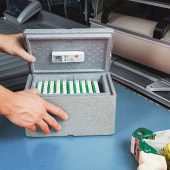If you check your car’s exhaust system, you’ll notice a bulbous part between the engine and the muffler. This is the catalytic converter. Your car may have two of them, a smaller one near the engine and a bigger one further back.
A catalytic converter converts harmful gasses from a combustion engine – namely hydrocarbons, carbon monoxide and oxides of nitrogen – into less harmful inert gasses.
The catalytic converter holds the catalyst that accelerates the oxidation-reduction reactions. Read on to learn more on how to test catalytic converter with infrared thermometer.
Common Problems with the Catalytic Converter
A malfunctioning catalytic converter can affect engine performance and even shut down the engine.
If your engine feels sluggish, has less acceleration or stalls when idling, it’s likely a problem with the catalytic converter.
Other signs of problems with the catalytic converter include overheating under the car, a rotten egg sulphur smell and dark exhaust smoke.
The likely issue is that the catalytic converter has clogged, restricting gas flow. This can cause overheating and reduce engine performance.
The converter may also get contaminated by engine emissions containing lead, sulphur, silicon or manganese. These ‘poisons’ prevent the catalyst inside the converter from reacting with harmful gasses from the engine.
A catalytic converter can also overheat because of a misfiring engine or a malfunctioning oxygen sensor.
Diagnosing a Catalytic Converter with an Infrared Thermometer
There are several ways to check if your catalytic converter is working properly. The easiest one is to check your dashboard.
If there’s a check engine light, it could indicate a problem with the catalytic converter. Take it in for a check-up.
Another method is to detach the catalytic converter from the header pipe that carries exhaust gasses into it. Then run the engine and see if it improves in performance. If it runs better, the catalytic converter is the problem – it’s likely clogged.
Another easy test you can do yourself at home is a temperature check. In a well-functioning catalytic converter, the rear of the converter where the outlet pipe connects should be hotter than the front where exhaust gasses come in.
The best way to do a temperature check is using an infrared thermometer. Here are the steps.
- Switch on the engine and let it idle for 20 minutes. This allows it to rise to its normal temperature. You can also take the car for a short drive on the road or highway then come back.
- Leave the engine idling and set the car in park (or neutral for a manual).
- Check if you have enough clearance to get under the car. If you don’t, raise the front of the car and support it on jack stands. The catalytic converter is usually located close to the engine so you only need to raise the front. Place car stoppers against the rear wheels for added safety.
- Take an infrared thermometer and measure the temperature at the front of the catalytic converter. You only need to measure the surface temperature so an infrared thermometer is perfect. It also allows you to maintain a safe distance from the hot converter.
- Make sure you hold the infrared thermometer at the right distance from the point whose temperature you are taking. A distance of about 12cm away from the surface of the converter will give you an accurate reading.
- Record the front reading then measure the temperature at the rear of the converter and record it as well.
Comparing the two readings will tell you whether your car’s catalytic converter is working as expected.
If the front and rear readings are similar or almost the same, there’s a problem. If the front temperature is higher than the rear temperature, there’s a problem.
If the rear temperature of the catalytic converter is 20 or more degrees hotter than the front, your catalytic converter is likely okay. If you are still experiencing problems with the engine and exhaust, check the muffler.
A working catalytic converter will have hotter gasses coming out at the rear compared to the exhaust gasses coming in.
If you get a lower rear temperature, it’s likely that the catalyst inside has deteriorated and is not converting exhaust gasses or it has clogged.
Take the car to the garage, where they may perform a different test (usually a vacuum or backpressure test) to confirm that the catalytic converter is malfunctioning.
Note
If your car has two catalytic converters, the temperature test works for both. You can also use an infrared thermometer to test a catalytic converter on other machines like a generator.



Had engine light problems for years, got it off once to pass inspection, now it’s on again, inspection due again, and I’m being told it’s the cat converter, no real symptoms of that, but my garage says they did a temp check, and the cat failed…But this has all been nebulous info for years, now it’s gonna cost…Any definitive reason it’s definitely the cat????